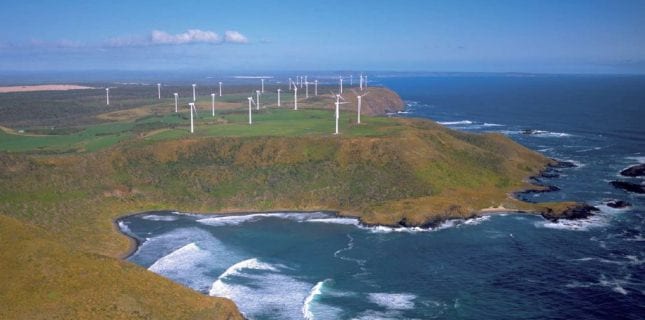From the moment Tasmania energy minister Guy Barnett took the podium at the All-Energy Australia conference on Thursday – wearing a tie tastefully decorated with tiny wind turbines – the contrast with his federal Liberal counterpart Angus Taylor could not have been more stark.
For starters – and perhaps in greatest contrast to Taylor – Barnett is not afraid to talk about his state’s “world-class wind” resource, and his party’s “every intention” of making the most of it, with major wind farms in the works and plans for many more.
“Today I’m wearing my wind turbine tie from Denmark – as a Senator I toured Denmark with the Vestas factory, and you can see the wind farms actually in the ocean just off the coast of Denmark,” he told the conference in his keynote address.
Taylor, it should be remembered, has campaigned for years against wind farms and in his only major speech to date, could not bring himself to mention wind as one of the energy options available to Australia.
And while Taylor insists there is already too much wind and solar in the system, Barnett is not afraid to talk up his state’s ambitious target of 100 per cent renewable, “fully self-sufficient” energy generation by 2022.
Granted, with their well established hydro power resource, Tasmania is already more than 90 per cent of the way there. But you won’t hear Barnett talk about building new baseload capacity, or relying on Victoria’s remaining “fair dinkum” coal supply to get by.
And as he himself put it on Thursday: “We, in that respect, are way ahead of the game; not just (compared to) all of our counterparts across the country who are targeting 30 per cent, and 40 percent and 50 per cent.
“We will get 100 per cent by 2022, and of course that’s almost unique throughout the globe – and we’re proud of that.”
And just in case Taylor, Morrison & Co were wondering, by that same date – 2022 – Barnett’s government is also aiming to have the lowest regulated power prices for residential and business customers.
“Tasmania has what the rest of the nation really wants, and needs, and that is low-cost energy, reliable or dispatch able energy, and clean energy – the trifecta.
“And this is a blessing we’d like to share with the rest of Australia.”
As geography would have it, this will mean more undersea connections to Victoria, which, as current politics would have it (at least until the November election), happens to be a Labor state.
But Barnett is not bothered by that.
After all, he knows that while Tasmania is spoiled for its renewable resources – both wind and water – it represents a tiny 1 per cent of the nation’s landmass, and so sending excess clean energy to the mainland is less of an option and more of a necessity.
He also knows, however, that Australia’s mainland states, like Victoria and NSW, will need to find alternatives to their ageing, soon to close forever, coal power fleets.
“If we can have access to market to share the low-cost, reliable, clean energy with you,” Barnett said.
“The studies that have been undertaken to date demonstrate that will further interconnection, that will open up the opportunity for pumped hydro and for further wind development.”
As we have reported, the state’s utilities and other companies have been working with ARENA to identify the state’s optimum pumped hydro sites, and to gather support and funding for the construction of at least one more high voltage undersea cable to the mainland.
The list of potential pumped hydro sites is currently at 14, and Barnett says it should be whittled down further to six or seven of the best by December. But those sites alone, he says, would add 2,5000MW of “beautiful, clean, renewable energy”– a doubling in capacity for the state.
“With the significant uptake of renewables in terms of wind and solar particularly in Victoria, what we have to offer in Tasmania complements, brilliantly.”
While Melbourne hits its peak demand on hot summers’ days, he notes, Tassie has its peak demand in winter, when home heaters are switched on, en masse.
“So, we complement one another beautifully; the Tassie-Victoria team effort can really make a wonderful difference, and I expect to be able to do that, going forward.”
But it is perhaps the state’s world-class wind resource, and the new projects both under construction and in the planning that aim to harness this resource, that Barnett is most excited about.
And that’s certainly something you won’t see mirrored in the federal Coalition.
“The beauty is, it complements what’s happening in Victoria, because our wind blows at a different time, particularly in the afternoon,” Barnett said.
“The intensity of the wind is at a different time and a different scale, and it will complement beautifully what’s happening here in Victoria, and on the mainland. So we can see the opportunity.
“If we can deliver that low-cost reliable energy to the mainland, of course, we then want to be globally competitive, and share that benefit with Victoria, NSW and the rest of the nation, so that we can all benefit in a global sense and complement the wonderful opportunities that we have, going forward.”
Barnett says new determinations on the feasibility of any new interconnectors between Victoria and Tasmania – identified by AEMO as a key ingredient to integrating high renewables gird in the 2020s – are expected to be delivered in December.










